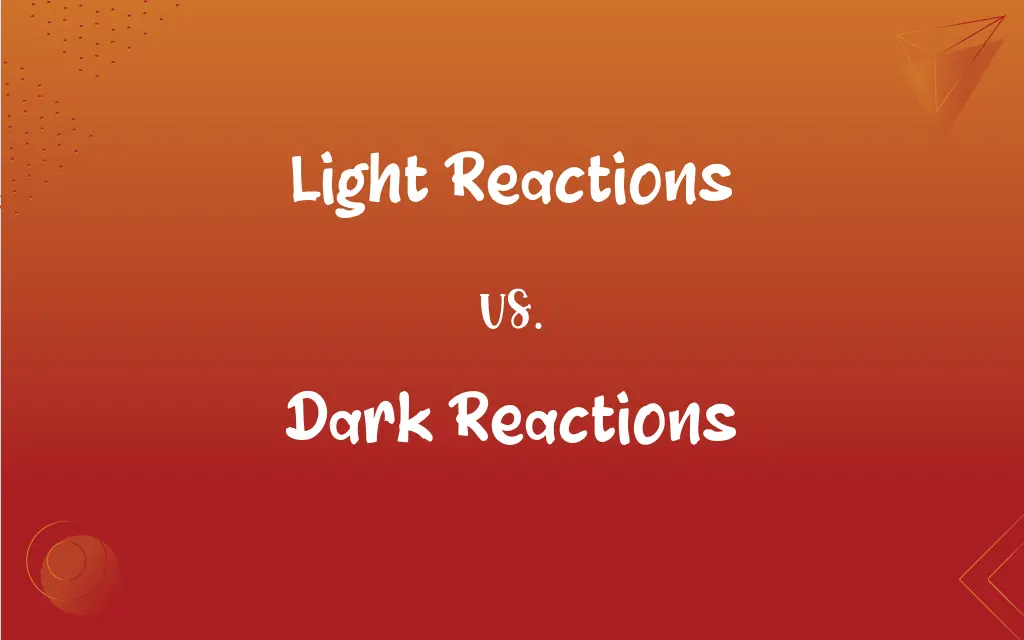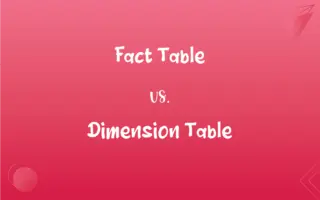Light Reactions vs. Dark Reactions: What's the Difference?
Edited by Janet White || By Harlon Moss || Updated on October 3, 2023
Light Reactions convert solar energy to chemical energy in chloroplasts; Dark Reactions use that energy to produce glucose from CO2.

Key Differences
Light Reactions occur in the thylakoid membranes of the chloroplasts and are driven by light energy. These reactions involve the use of light energy to convert water and ADP into oxygen, ATP, and NADPH. Notably, Light Reactions are the initial phase of photosynthesis and are crucial for providing the energy carriers needed in the subsequent phase.
Dark Reactions, occurring in the stroma of the chloroplast, utilize the ATP and NADPH produced by the Light Reactions. This phase is also known as the Calvin Cycle, where carbon dioxide is fixed and subsequently transformed into glucose. While they follow Light Reactions, Dark Reactions are not dependent on direct light exposure.
Light Reactions prominently involve pigments like chlorophyll, which absorb light and facilitate the creation of energy carriers. Through photolysis, water molecules are split, generating oxygen as a by-product and energizing electrons. The energized electrons then aid in producing ATP and NADPH.
Dark Reactions involve a series of enzymatic reactions, leading to the production of glucose. Carbon atoms from CO2 are fixed into an organic molecule through a cycle of reactions. Unlike Light Reactions, these processes do not directly utilize light, but the energy carriers formed during the light-dependent stage fuel these reactions.
Both Light Reactions and Dark Reactions are imperative for photosynthesis, collectively transforming light energy into chemical energy and storing it in glucose. While physically and functionally distinct, these processes are sequentially linked, highlighting the elegant efficiency of photosynthesis.
ADVERTISEMENT
Comparison Chart
Dependency on Light
Directly dependent
Not directly dependent
Location
Thylakoid membranes
Stroma of chloroplast
Main Products
ATP, NADPH, O2
Glucose
Phase in Process
First phase
Second phase
Involvement
Photolysis of water
Carbon fixation
ADVERTISEMENT
Light Reactions and Dark Reactions Definitions
Light Reactions
Light Reactions encompass the electron transport chain.
In Light Reactions, energized electrons are transported through membrane proteins.
Dark Reactions
Dark Reactions are also termed the Calvin Cycle.
The Calvin Cycle, synonymous with Dark Reactions, fixes carbon dioxide into glucose.
Light Reactions
Light Reactions involve the absorption of light to produce ATP and NADPH.
The Light Reactions in plants yield oxygen as a by-product.
Dark Reactions
Dark Reactions don’t require direct light to proceed.
Dark Reactions continue even during the night, utilizing stored energy.
Light Reactions
Light Reactions necessitate water and light.
Light Reactions split water molecules, releasing oxygen.
Dark Reactions
Dark Reactions occur in the chloroplast stroma.
The enzymes facilitating Dark Reactions are located in the chloroplast stroma.
Light Reactions
Light Reactions generate the energy used in Dark Reactions.
The ATP produced in Light Reactions is vital for the Calvin Cycle.
Dark Reactions
Dark Reactions incorporate CO2 into organic molecules.
Through Dark Reactions, inorganic carbon is transformed into organic forms.
Light Reactions
Light Reactions occur in the thylakoids of chloroplasts.
During Light Reactions, photons energize chlorophyll molecules.
Dark Reactions
Dark Reactions facilitate the synthesis of glucose.
Dark Reactions use ATP and NADPH to produce glucose.
FAQs
Do Light Reactions only occur during the day?
Yes, they require light and typically occur during daylight hours.
Can Light Reactions occur in artificial light?
Yes, as long as the light spectrum contains the necessary wavelengths.
What is produced as a by-product in Light Reactions?
Oxygen (O2) is produced as a by-product.
Where do Light Reactions occur?
In the thylakoid membranes of chloroplasts.
Why are Dark Reactions also referred to as the Calvin Cycle?
Because they involve a cyclical series of reactions first elucidated by Melvin Calvin.
Can Dark Reactions proceed without light?
Yes, Dark Reactions can occur in the absence of direct light.
What is the main purpose of Light Reactions?
To convert light energy into chemical energy in the form of ATP and NADPH.
What is the primary function of Dark Reactions?
To utilize ATP and NADPH from Light Reactions to produce glucose from CO2.
How does the absence of sunlight affect Dark Reactions?
They can proceed as long as there are sufficient stored ATP and NADPH.
Are there different types of Light Reactions?
There are variations, but the Z-scheme, involving Photosystems I and II, is standard.
What role do enzymes play in Dark Reactions?
Enzymes facilitate the conversion of CO2 into glucose in the Calvin Cycle.
Can variations exist in Dark Reactions across different species?
While the core process is consistent, specific enzymatic activities and regulatory mechanisms may vary between species.
What would happen if Light Reactions did not occur in plants?
Dark Reactions would be unable to proceed due to a lack of ATP and NADPH.
Can Dark Reactions occur in organisms other than plants?
Yes, they also occur in algae and certain bacteria that perform photosynthesis.
Do Light Reactions and Dark Reactions occur simultaneously?
Yes, during daylight, both processes can occur concurrently in chloroplasts.
How is water utilized in Light Reactions?
Water is split to release electrons, protons, and oxygen in the process of photolysis.
Are Light Reactions and Dark Reactions interconnected?
Yes, products of Light Reactions (ATP and NADPH) are used in Dark Reactions.
Where do Dark Reactions take place within the cell?
In the stroma of chloroplasts.
Are Dark Reactions essential for plant survival?
Yes, they enable the synthesis of glucose, an energy source and building block.
What happens to the ATP and NADPH produced in Light Reactions?
They are utilized in Dark Reactions to help convert CO2 into glucose.
About Author
Written by
Harlon MossHarlon is a seasoned quality moderator and accomplished content writer for Difference Wiki. An alumnus of the prestigious University of California, he earned his degree in Computer Science. Leveraging his academic background, Harlon brings a meticulous and informed perspective to his work, ensuring content accuracy and excellence.
Edited by
Janet WhiteJanet White has been an esteemed writer and blogger for Difference Wiki. Holding a Master's degree in Science and Medical Journalism from the prestigious Boston University, she has consistently demonstrated her expertise and passion for her field. When she's not immersed in her work, Janet relishes her time exercising, delving into a good book, and cherishing moments with friends and family.































































